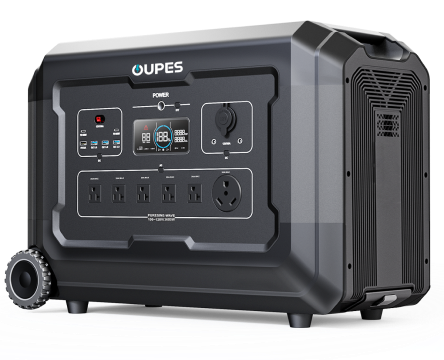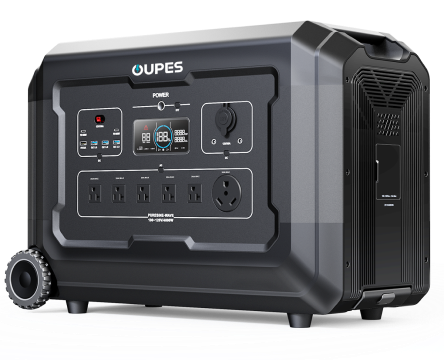Electricity disruptions, though often brief, occasionally extend into protracted spans, stretching over days or even multiple weeks. This temporal spectrum, seemingly expansive, is influenced by a myriad of elements that determine the swiftness of power restoration. Therefore, investing in a portable power station is very necessary.
Your familiarity with the operational patterns of your electricity provider may offer some foresight into the duration of such blackouts, based on the following considerations:
What Caused the Power Outage
The catalyst behind an electrical blackout significantly influences the duration required to re-establish power.
In instances where the disruption is minor, such as a toppled conductor, restoration efforts by utility brigades might span a mere couple of hours. Conversely, when the blackout stems from tempestuous climatic conditions or a cataclysmic event, the absence of electricity could extend over numerous days, or in particularly dire scenarios, span across several months.
Should an electrical standard bearer succumb to collapse, a minimum of a full day's labor awaits the power company before functionality is reinstated. In grave circumstances, such as the entire power facility being compromised, the ensuing power void could last approximately a week.
In situations where a calamitous event or malfunction leads to a plant's cessation, electricity from alternate facilities is integrated into the grid as a compensatory measure for the disrupted supply.
Assessing the Damage
Delving into the genesis of a malfunction often devours a predominant portion of a utility worker's schedule. When a power pole yields to the inexorable pull of gravity, pinpointing the cause is a task of minimal complexity.
In contrast, unraveling the enigmas of subterranean cables, particularly in instances where they lie shrouded beneath the terrestrial crust, necessitates an elongated span of analytical reasoning. Whereas the amendment of a standard power line may unfold within a handful of hours, the restoration of these interred conductors may protract into a duration spanning weeks.
The Damage in Your Area

In the wake of tumultuous storms or catastrophic events, power industry titans implement a rigorously devised strategy to accelerate the reconstitution of electric supply, targeting the greatest number of beneficiaries. This operation was initiated with a moral assessment of the havoc wreaked, and succeeded by the revitalization of electricity substations and pivotal structures, especially healthcare institutions.
After that, the restoration squads embark on the task of reinvigorating domiciles. Generally, the vicinity of energy distribution networks indicates a more rapid reconnection. In contrast, areas besieged by extensive destruction might encounter elongated interruptions, especially when the disturbance is isolated to a meager cluster of end-users.
Available Resources
In such dire circumstances, the disparity in resource allocation becomes starkly evident. Urban landscapes, brimming with technological advancements, often have a surfeit of adept individuals and sophisticated apparatus at their beck and call. This abundance facilitates a brisk and efficient response to any infrastructural upheaval.
On the other hand, rural expanses, with their tranquil vistas, often bear the brunt of resource scarcity. The limited availability of both cutting-edge tools and seasoned experts in these serene but isolated locales significantly hampers the speed and efficacy of recovery operations.
In emerging nations, where infrastructure is still in its embryonic stage, this chasm in resource distribution is even more pronounced, often leading to prolonged periods of disruption and a slower trajectory toward normalcy.
How to Fix the Damage

In the realm of electrical infrastructure, digital anomalies can swiftly be addressed remotely, thanks to advancements in technology. Engineers can diagnose and resolve these issues using sophisticated software, reducing downtime and improving the power grid's efficiency.
However, tangible impairments, caused by environmental factors or physical damage, require a labor-intensive, hands-on approach. Lineworkers must locate the fault, assess the damage, and perform necessary repairs, adhering to strict safety protocols.
Before fully restoring electricity, lineworkers conduct thorough examinations to ensure the system's stability and safety. In summary, while digital malfunctions can be quickly fixed remotely, physical impairments demand a lengthier, manual process, followed by thorough inspections to guarantee power supply reliability and safety.
Long-term Issues
When an electrical grid becomes overwhelmed, resulting in a blackout, resolving the issue entails more than mere repairs. Power utilities frequently employ staggered blackouts as a means to avert extended, more severe disruptions. These premeditated, temporary power interruptions, typically spanning a few hours, serve to stabilize the grid.
Consumers generally receive advance notification of these planned blackouts, allowing them to make preparations by adjusting their timetables or making alternative arrangements. This approach not only aids in the management of grid stability but also mitigates inconvenience to the populace.
Such measures underscore the imperative for enhancing power infrastructure and investing in sustainable energy solutions to meet escalating demands and guarantee a more robust power supply system.
Prepare for Short & Extended Outages
Amidst the prevalence of natural gas generators in our current era, their efficacy wanes significantly in the face of natural calamities. In stark contrast, the OUPES portable power station offers a liberating alternative. These devices obviate the necessity of stockpiling combustible fuels, rendering them a safer option for indoor electrification during inclement weather conditions.
The preparedness inherent in the OUPES portable power station is a blessing, ensuring its readiness for unforeseeable emergencies. Charging alternatives encompass AC, solar, automobile, AC+solar, and dual AC. In the absence of conventional power sources, the deployment of portable solar arrays has emerged as a viable means to rejuvenate portable battery reserves.
Take, for instance, the OUPES 2400 Portable Power Station, equipped with a 2400W AC pure sine wave inverter, boasting an exceedingly capacious capacity of 2232Wh and a formidable output power rating of 2400W. It is well-suited for powering over 95% of household appliances and can sustain a 150W refrigerator for a duration spanning 17 to 30 hours. It stands as a dependable off-grid power source during instances of power interruptions or outages.
Irrespective of the duration, be it a fleeting power interruption or an enduring grid failure, your portable power station can function as an impregnable bastion, ensuring uninterrupted operation for essential equipment within your domicile.
Conclusion

In conclusion, the duration of a power outage can fluctuate significantly contingent on a myriad of factors, encompassing the etiology of the outage, the magnitude of devastation, the resources attainable for restitution, and the geographical vicinity of the afflicted area.
While certain outages may be expeditiously resolved within mere hours, others, particularly those precipitated by inclement climatic conditions or cataclysmic occurrences, have the potential to persist for days, or even span into weeks.
The paramount lesson derived from comprehending the intricacies of power outages lies in the significance of being adequately prepared. Investing in a portable power station can furnish a dependable source of electrical energy during these periods of disruption.
Dive into our curated collection of OUPES portable power stations to ascertain the model that harmonizes most aptly with your requisites.

































Leave a comment
This site is protected by hCaptcha and the hCaptcha Privacy Policy and Terms of Service apply.